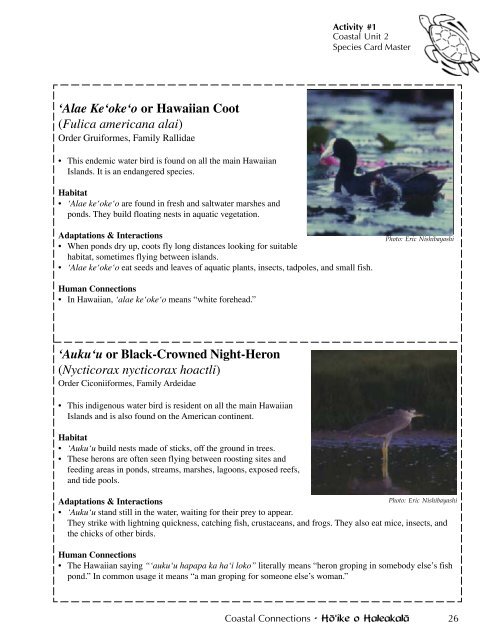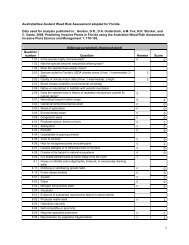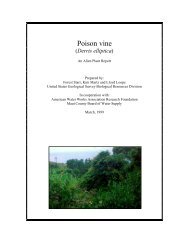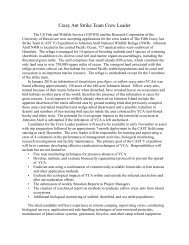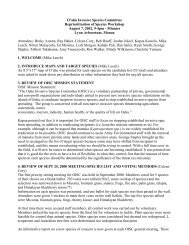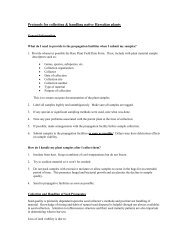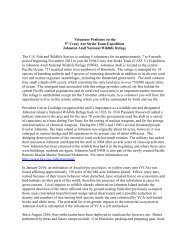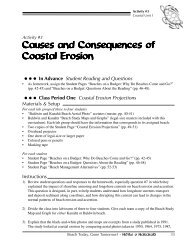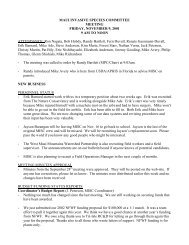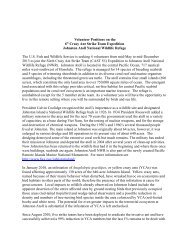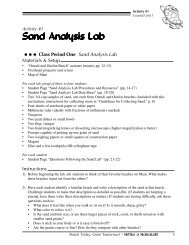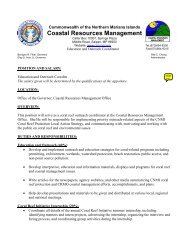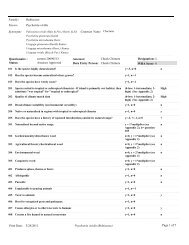Coastal - Hawaiian Ecosystems at Risk project
Coastal - Hawaiian Ecosystems at Risk project
Coastal - Hawaiian Ecosystems at Risk project
Create successful ePaper yourself
Turn your PDF publications into a flip-book with our unique Google optimized e-Paper software.
Activity #1<br />
<strong>Coastal</strong> Unit 2<br />
Species Card Master<br />
ÿAlae Keÿokeÿo or <strong>Hawaiian</strong> Coot<br />
(Fulica americana alai)<br />
Order Gruiformes, Family Rallidae<br />
• This endemic w<strong>at</strong>er bird is found on all the main <strong>Hawaiian</strong><br />
Islands. It is an endangered species.<br />
Habit<strong>at</strong><br />
• ÿAlae keÿokeÿo are found in fresh and saltw<strong>at</strong>er marshes and<br />
ponds. They build flo<strong>at</strong>ing nests in aqu<strong>at</strong>ic veget<strong>at</strong>ion.<br />
Adapt<strong>at</strong>ions & Interactions<br />
• When ponds dry up, coots fly long distances looking for suitable<br />
habit<strong>at</strong>, sometimes flying between islands.<br />
• ÿAlae keÿokeÿo e<strong>at</strong> seeds and leaves of aqu<strong>at</strong>ic plants, insects, tadpoles, and small fish.<br />
Photo: Eric Nishibayashi<br />
Human Connections<br />
• In <strong>Hawaiian</strong>, ÿalae keÿokeÿo means “white forehead.”<br />
ÿAukuÿu or Black-Crowned Night-Heron<br />
(Nycticorax nycticorax hoactli)<br />
Order Ciconiiformes, Family Ardeidae<br />
• This indigenous w<strong>at</strong>er bird is resident on all the main <strong>Hawaiian</strong><br />
Islands and is also found on the American continent.<br />
Habit<strong>at</strong><br />
• ÿAukuÿu build nests made of sticks, off the ground in trees.<br />
• These herons are often seen flying between roosting sites and<br />
feeding areas in ponds, streams, marshes, lagoons, exposed reefs,<br />
and tide pools.<br />
Adapt<strong>at</strong>ions & Interactions<br />
• ÿAukuÿu stand still in the w<strong>at</strong>er, waiting for their prey to appear.<br />
They strike with lightning quickness, c<strong>at</strong>ching fish, crustaceans, and frogs. They also e<strong>at</strong> mice, insects, and<br />
the chicks of other birds.<br />
Photo: Eric Nishibayashi<br />
Human Connections<br />
• The <strong>Hawaiian</strong> saying “ÿaukuÿu hapapa ka haÿi loko” literally means “heron groping in somebody else’s fish<br />
pond.” In common usage it means “a man groping for someone else’s woman.”<br />
<strong>Coastal</strong> Connections • Höÿike o Haleakalä 26


